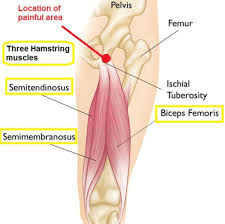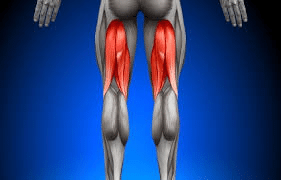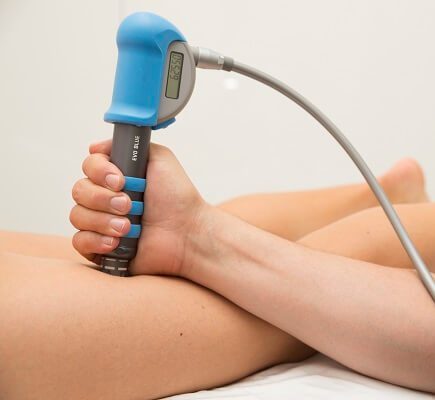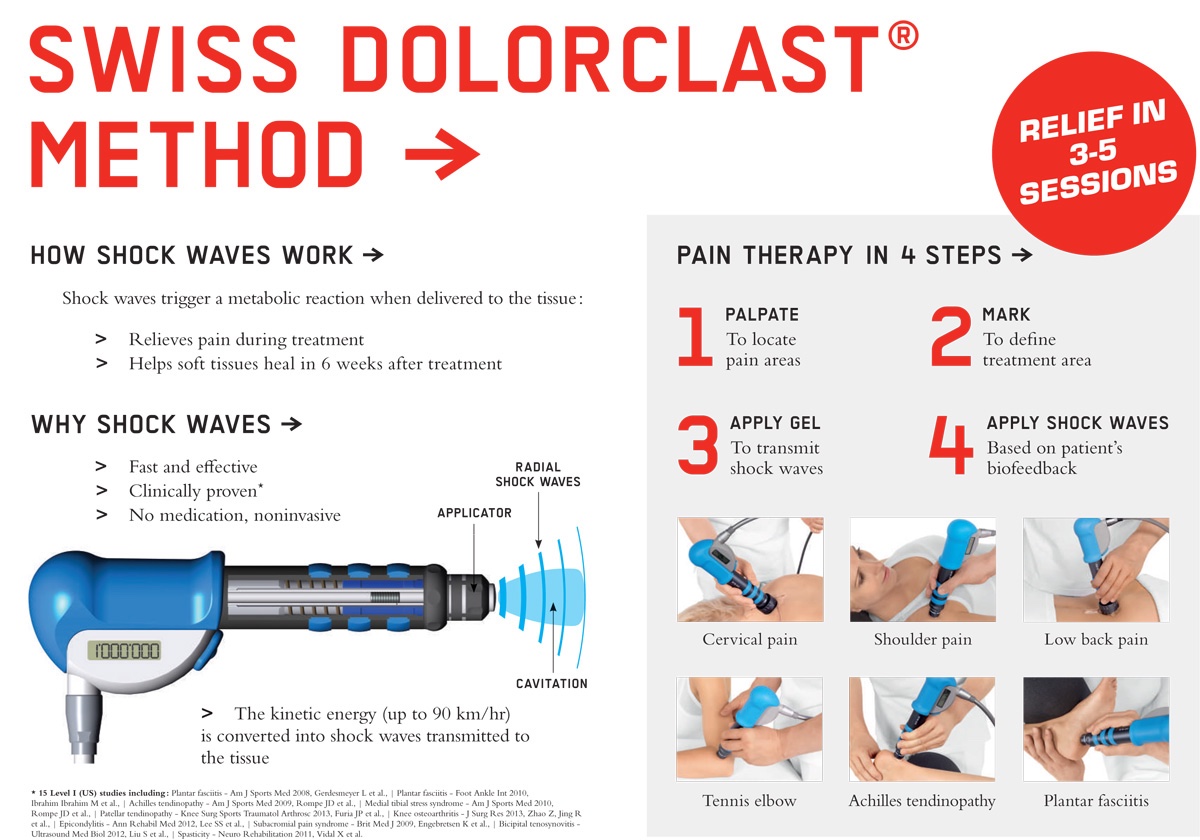Shockwave Therapy for Hamstring Tendinopathy
Hamstring tendinopathy is an often-overlooked diagnosis for acute and chronic ongoing buttock pain. The symptoms often mimic sciatic symptoms and indeed there may be co-existent sciatic nerve irritation also. The Hamstring tendon attaches deep to the gluteus maximus muscles on either buttock region, onto the ischial tuberosity just beside the sciatic nerves path. The injury is very common in long distance runners and is often aggravated by running, acceleration and direct pressure to the hamstring tendon (at the upper end). Pain when sitting is normally the result of a severe tendinopathy.
The hamstrings (semi-membranosus, semi-tendinosus and the long head of biceps femoris) are prone to damage during the eccentric phase of the running gait (mainly when the eccentric load is applied to the hamstring muscle group).
The most eccentric load is placed on the hamstring tendon during the phase of running when the hip is flexed and the knee is extended (when the quads are fully active and the lower leg is accelerating forwards and upwards around the knee joint).
There are numerous biomechanical factors that are believed to contribute to hamstring tendinopathy. It is important these are addressed also, and you undergo thorough Gait Analysis and assessment with a Podiatrist to address the underlying issues is key. The common biomechanical factors we see which relate to the development of hamstring tendinopathy include:
- Hamstring tightness
- Poor warm up
- History of previous injuries to the hamstring
- Poor quad to hamstring ratio
- Pelvic instability
- Poor running biomechanics
- Poor core stability
- Poor or worn out Footwear

What other treatments are available for hamstring tendinopathy?
Other treatments that are available for hamstring tendinopathy include the following:
- Steroid Injections
- Surgery
- Eccentric loading
- Shockwave therapy
- Anti-inflammatories (oral or injectable)
- PRP injections
- Hamstring stretching
- Pelvic Alignment
- Hamstring Strengthening

How is shockwave therapy applied to hamstring tendinopathy?
Shockwave therapy for hamstring tendinopathy is applied following a set protocol. The clinician will carry out a thorough case history taking which isolates the area that is painful and begins to understand the clinical history behind the condition. It is important to make sure that the condition being treated is actually a hamstring tendinopathy and is therefore treatable with shockwave therapy.
During the examination period a tender point where the pain is maximal will be located, upon which a water-based medium will be applied. This aids the transmission of the impulses into the desired area.
The probe will then be placed over the desired area and then treatment for your hamstring tendinopathy will begin. At first the Podiatrist will ensure the discomfort is kept to a minimum. After a while as the impulses increase little pain is felt. Although, more often than not there is some pain felt over the area of application. After treatment you should feel very little pain and this may last for a few days. After this, an aching sensation can occur. Following subsequent treatments there will be a definite improvement in symptoms leading to reduction in the original pain felt.
How long will shockwave therapy take to work?
Generally most applications of shockwave for hamstring tendinopathy and most conditions will resolve within 3-4 sessions of 30 minutes (roughly). This obviously can depend on the exact presentation of the condition. Making sure you see someone quickly to have the condition diagnosed can reduce the number of sessions needed.
It is vital that you continue to work with a physical therapist to maintain the exercise regime you should already be carrying out for hamstring tendinopathy, prior to consulting for shockwave treatment. This will involve balancing exercises, strength exercises and a good eccentric loading programme depending on your stage of hamstring tendinopathy.
A recent randomized controlled trial demonstrated potential benefit of the shockwave treatment. Forty professional athletes with proximal hamstring tendinopathy were divided into 2 groups, one receiving shockwave therapy and 1 receiving non-steroidal anti-inflammatory drugs, ultrasound, and physical therapy exercises. After 3 months, 80% of the athletes in the shockwave therapy group were able to return to their pre-injury level of sport, compared with none of the athletes in the control group. There was also a significant reduction in pain in the shockwave therapy group (Cacchio 2011).
How long will the treatment last for?
If everything goes to plan with your shockwave therapy for hamstring tendinopathy then the treatment should make a significant contribution to reducing the pain and improving the function of your hamstring tendinopathy. In most cases the shockwave will get rid of the patellar tendinitis.
With some tendon surgery there is a 75% success rate at 18 months, with shockwave for the same condition it has been shown that up to 80% of patients who have received the shockwave therapy at 18 months have a good to excellent result. Shockwave is better than surgery for certain tendinopathy and more research is being done with this in mind.
Shockwave Therapy is:
- Affordable
- In Office Procedure
- Walk-In / Walk-Out
- No Time Off Work
- Clinically Proven
- No Drugs Or Side-Effects
Dolorclast Radial Shock Wave Therapy is a non-invasive treatment for the treatment of Hamstring Tendinopathy.
(click to enlarge)
How does Dolorclast Shockwave Therapy work?
Dolorclast shockwave therapy works in 2 ways:
- Reducing pain by decreasing the chemical messengers responsible for the transmission and perception of pain
- Improved local blood flow to the sore area through the physical effects of the treatment and the promotion of new blood vessel growth in the area.
What does the Dolorclast Shockwave Therapy involve?
After the painful site is identified, shock waves are delivered to the site. Initially the treatment can be uncomfortable but as the treatment progresses the intensity usually improves. An instant improvement in pain is usually noted after the treatment.
The Foot and Ankle Clinic is proud to have pioneered the use of Shockwave Therapy in Australia since its inception several years ago and therefore all our Podiatrists have vast experience using shockwave therapy and have done extensive training in shockwave therapy and its applications.
At the Foot and Ankle Clinic our highly qualified team of Podiatrists are all members of the Australian Podiatry Association and offer a combined 50 years’ experience.
Put your feet in our hands! See us today in Chadstone, Moe, Sale, Traralgon, Warragul & Online Store and Retail Enquiries. NO REFERRAL NEEDED!.



